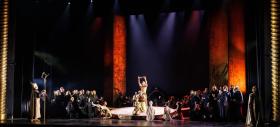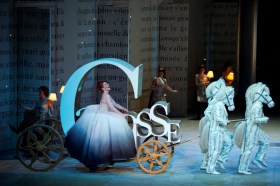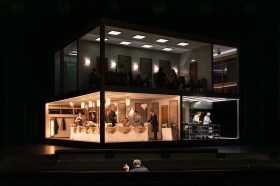Aphrodite was a multifaceted artistic exploration of concepts and ideologies associated with feminine beauty, self-worth and desirability. This evocative work marked the fourth opera by acclaimed US composer Nico Muhly and was specially written for performance by the Sydney Chamber Opera in collaboration with the Omega Ensemble.
Aphrodite was a sophisticated and conceptually rich production, integrating diverse artistic, visual and philosophical practices unfolding simultaneously.
The production was compelling on multiple levels, inviting us to reflect on historical myths and ideologies surrounding beauty and feminine worth, and to recognise their enduring influence in contemporary society.
The story centres on Ava (Jessica O’Donoghue), who returns to her hotel room after attending the launch of a new Netflix documentary based on her best-selling book, The Aphrodite Complex. An academic and mother of three, Ava is coping with the aftermath of a failed marriage and is being consumed by fantasies of Hector, a young director of photography with whom she has had a passionate affair.
Alone in her hotel room, Ava outlines the crux of her thesis on the Greek mythological figure Aphrodite. She describes how Aphrodite was required to compete with other goddesses in a beauty contest, while a mortal man, Paris, decided which of them was the most beautiful and worthy of the golden apple. Ultimately, the apple was awarded to Aphrodite, who was declared the goddess of love, beauty and desire.
Ava enters a period of intense self-loathing, fixated on her ageing appearance and perceived loss of value. This emotional turmoil is echoed in the music, which features agitated string lines, dramatic piano passages, and sharp percussive strikes.
From this inner struggle emerges a manifestation of the goddess Aphrodite (Meechot Marrero). Through her interaction with Aphrodite, Ava comes to the realisation that she is a victim of the pervasive ‘beauty myth’.
The set was modern and minimal, resembling a perfectly arranged hotel room. Statues of the Venus de Milo (Aphrodite) were subtly placed in both the bathroom and main room, suggesting that her image functioned as a commonplace decorative object – quietly embedded in the background of our collective psyche.
The costumes were clever, offering more than just a satirical nod to iconic goddesses of beauty, with both performers wearing full-length deep pink satin gowns and faux diamond necklaces – referencing Madonna’s ‘Material Girl’ and Marilyn Monroe’s ‘Diamonds are a Girl’s Best Friend’ from Gentlemen Prefer Blondes.
With its stimulating visual staging, the production brought together a chamber ensemble at the front of the stage and a sweeping digital screen overhead. The screen not only carried the libretto subtitles, but also a stream of live and recorded footage of Ava, captured from various vantage points around the venue to create a fragmented, cinematic portrait.
As Ava told her story, the audience was invited to scrutinise her physical form through black-and-white video close-ups that isolated and lingered on selected parts of her body, effectively objectifying her. This visual framing presented her as an externalised image – an object within the frame.
Aphrodite was slightly deficient in its ability to move and affect an audience. This may have been due to the lingering effects of Ava’s deliberate objectification. The audience depended on Ava to generate emotional resonance, and even after she outwardly acknowledged and rejected her indoctrination, her relatability remained elusive. It’s unclear whether this was an intentional choice by the production, but either way, it reflected the real-world difficulty women face when they are measured – and measure themselves – by external standards of beauty and desirability.
O’Donoghue and Marreo’s impressive vocal strengths were evident; however, the production failed to fully showcase their range and talent, offering limited variation in tone and subtlety over the duration of an hour. Both performers are sopranos, and the similarity in their vocal delivery ultimately detracted from the vocal aesthetics. While this may have been a deliberate artistic choice, it reduced the emotional impact and became slightly grating.
Read: Theatre review: Coriolanus, The Neilson Nutshell
Overall, this production was successful, particularly if you were seeking cerebral engagement complemented by musical and visual stimulation that played across multiple dimensions of perception and interpretation.
Aphrodite, Carriageworks
Company: Sydney Chamber Opera and Omega Ensemble
Music: Nico Muhly
Libretto: Laura Lethlean
Conductor: Jack Symonds
Director and Lighting Designer: Alexander Berlage
Set and Costume Designer: Isabel Hudson
Video Designer: Morgan Moroney
Technical Director: Damion Holling
Camera Operator: Mitchell Riley
Stage Manager: Georgiane Deal
Assistant Conductor: Huw Belling
Assistant Director: Zoë Hollyoak
Surtitles: Alexander Maltas
Head Electrician: Suzy Brooks
Head Mechanist: Stephen Crossley
Mechanist: Jan Goldfelder
Systems Technician: Chloe Langdon
Wigs: Annabel Cameron
Performers: Jessica O’Donoghue, Meechot Marrero
Omega Ensemble: David Rowden (Clarinet and Artistic Director), Véronique Serret (Violin 1), Mark Ingwersen (Violin 2), Neil Thompson (Viola), Paul Stender (Cello), Vatche Jambazian (Piano), Rebecca Lloyd-Jones (Percussion)
Aphrodite played at Carriageworks, Sydney from 20 June to 28 June 2025.





